https://www.philahomeopathy.com/natural-treatment-for-anemia/
Treatment for anemia should be initiated as soon and the diagnosis of this disease and the type of anemia are confirmed. If you have been diagnosed with Anemia, it is important to know and understand that the anemia treatment that you will be ordered to follow by your doctor will be based on the type of anemia that you suffer from. If you have this medical condition, it is because there are abnormalities related to the red blood cells in the body.
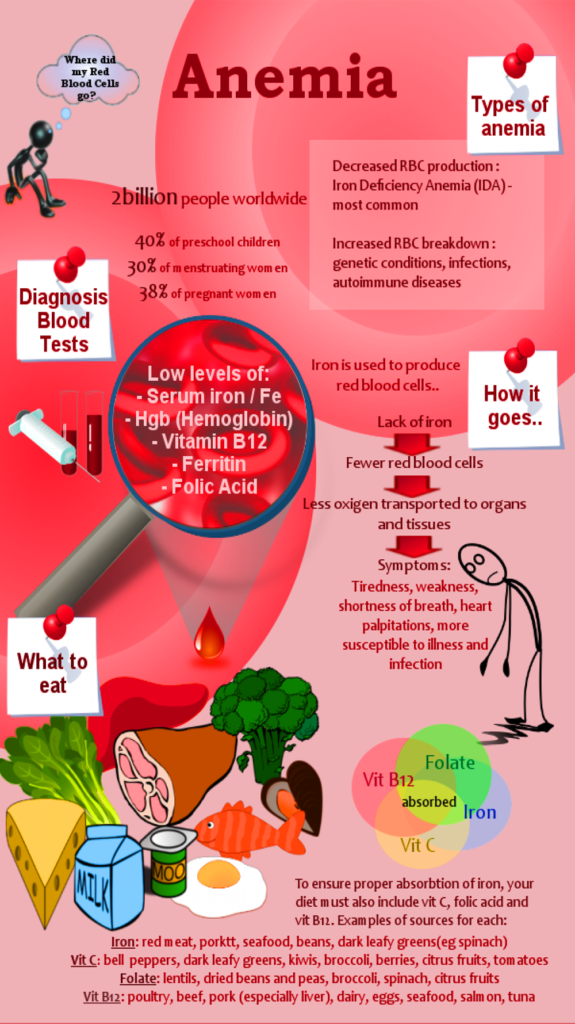
These cells work directly with the lungs in that they absorb a certain percentage of oxygen so that the oxygen may be transported to all other areas of the body, including the organs. When there is a reduction or complication associated with these blood cells, the body has an issue properly maintaining itself.
Listed below are different most common approaches to treatment for anemia:
- Iron deficiency anemia. Treatment for this type of anemia usually involves taking iron supplements and changing your diet.
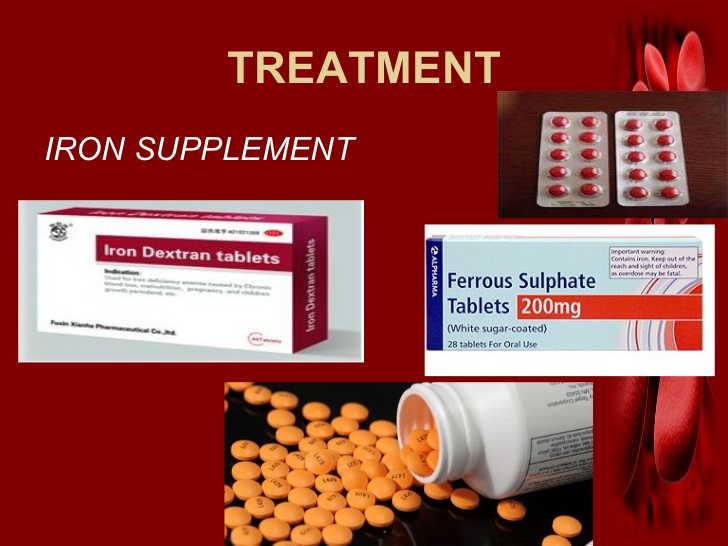
- Vitamin deficiency anemia. Treatment of anemia of this type involves supplementing foods and increasing these nutrients in your diet.
- Hemolytic anemia. Anemia treatment in case of hemolysis includes infections and taking drugs that suppress your immune system and attack your red blood cells. Depending on the cause of hemolytic anemia in your particular case, you may be referred to a cardiovascular specialist.
- Aplastic anemia. Treatment for low hemoglobin as a result of this type of anemia may include blood transfusions to raise red blood cell levels. You may need a bone marrow transplant if your bone marrow cannot produce healthy blood cells.
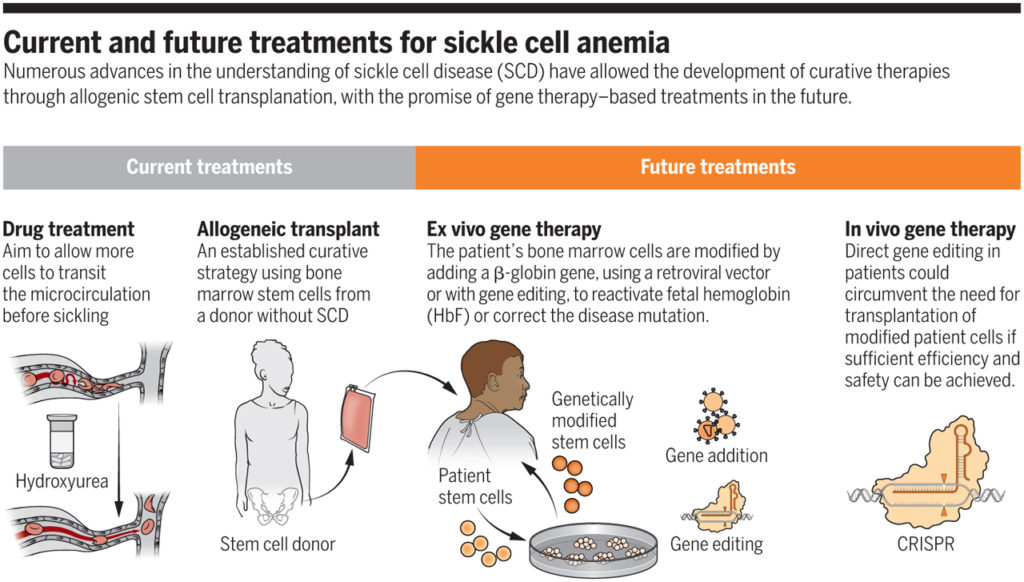 anemia. Anemia treatment may include oxygen, pain relievers, and oral and intravenous fluids to relieve pain and prevent complications. Doctors may also recommend blood transfusions, folic acid supplements, and antibiotics.
anemia. Anemia treatment may include oxygen, pain relievers, and oral and intravenous fluids to relieve pain and prevent complications. Doctors may also recommend blood transfusions, folic acid supplements, and antibiotics.
Although there are different conventional treatments for anemia, natural Treatment for anemia has been proven to be effective. What is more important that properly prescribed natural treatment of anemia causes no side effects.
Anemia is a blood condition that affects approximately 3.5 million Americans. Women are at higher risk of developing anemia than men. People who have other diseases such as cancer have a higher tendency to develop anemia. Anemia can become a very serious condition that can be dangerous. Anemia can also be acute or chronic.
What is anemia?
Anemia occurs when you do not have enough red blood cells or hemoglobin to produce sufficient oxygen. As a result, your organs are affected because they don’t get enough oxygen to function. There is a relationship between anemia and the kidneys, bone marrow, and nutritional deficiencies in the body. When the kidneys are not working well or you are malnourished, this will affect your red blood cell count. Since red blood cells are made in the bone marrow the health of bone marrow is very important.
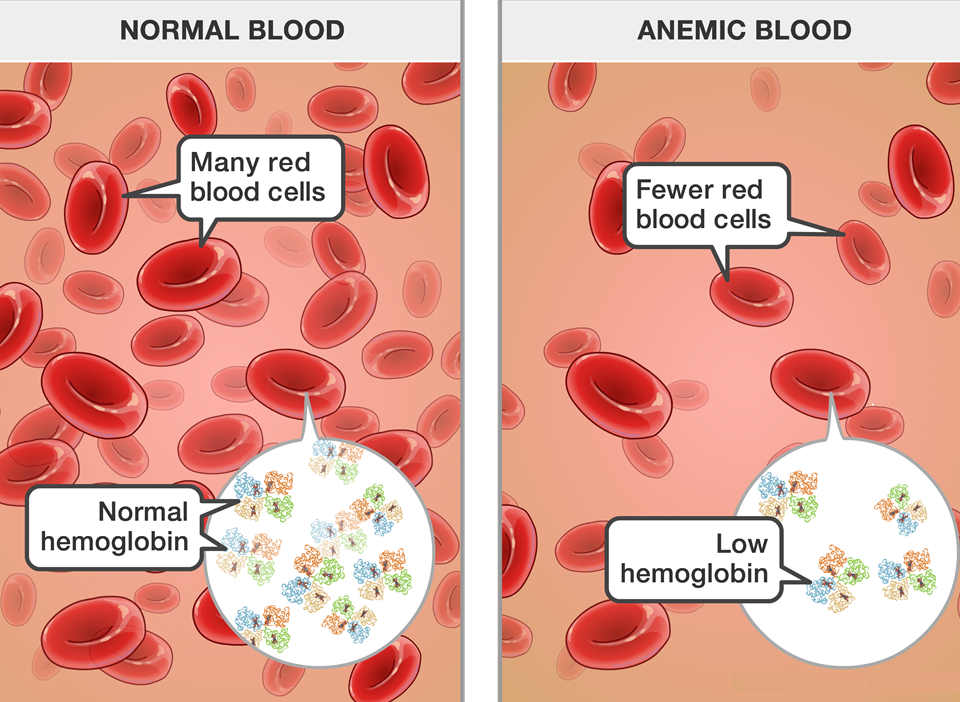
There are other instances where a person is considered to have Anemia disease. One instance is when the red blood cells located throughout the body fail to contain an appropriate level of hemoglobin. Hemoglobin has two main functions. First, it is a protein that assists in ensuring the color of the blood in the body. Second, it assists in the task of the red-based blood cells in moving oxygen from the respiratory system to the other areas of the body.
Understanding the Function of the Red Blood Cells
The red blood cells in the body have a couple of different functions. These cells are also referred to as “Erythrocytes”. When it comes to the body, these cells are considered to be the most common as far as blood cells. A lot of medical professionals also refer to these cells as “RBCs”, “Haematids”, “Red Blood Corpuscles”, “Erythrocytes”, and even “Erythroid Cells”. Each of these cells has a section that is identified as “Cytoplasm”.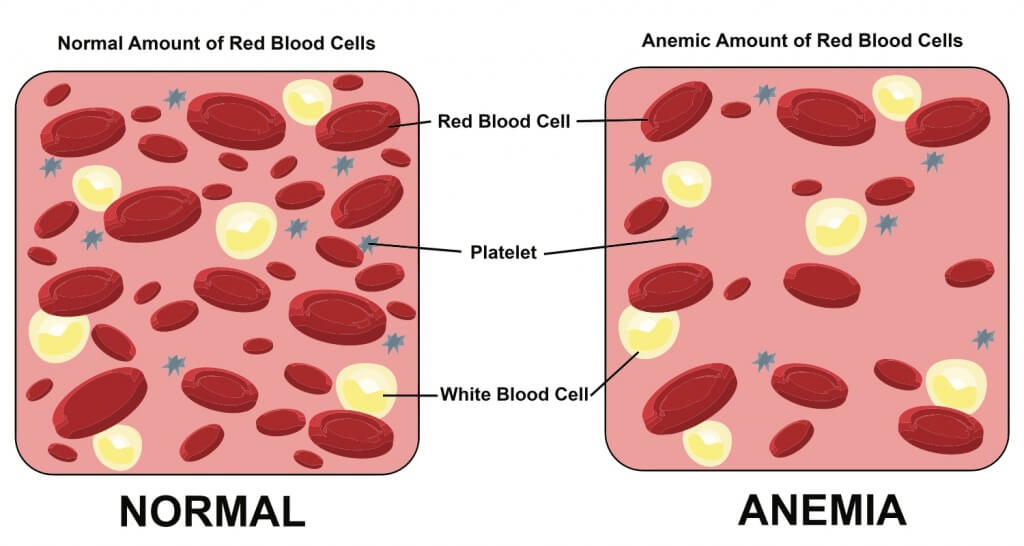 When reviewing the general anatomy of the red blood cell, you will find that the cytoplasm is extremely important as it contains hemoglobin. This is a protein biomolecule that contains high levels of iron. It allows the red blood cells to appropriately bind oxygen so that it can be transported to all areas of the body and also creates the color of blood.
When reviewing the general anatomy of the red blood cell, you will find that the cytoplasm is extremely important as it contains hemoglobin. This is a protein biomolecule that contains high levels of iron. It allows the red blood cells to appropriately bind oxygen so that it can be transported to all areas of the body and also creates the color of blood.
Types of anemia
There are different types of anemia and each requires specific treatment. Understanding the different types of anemia can help you understand the treatment options available and also prevent various health disorders that result from anemia. . Listed below are the common types of anemia.
Different types of deficiency anemias.
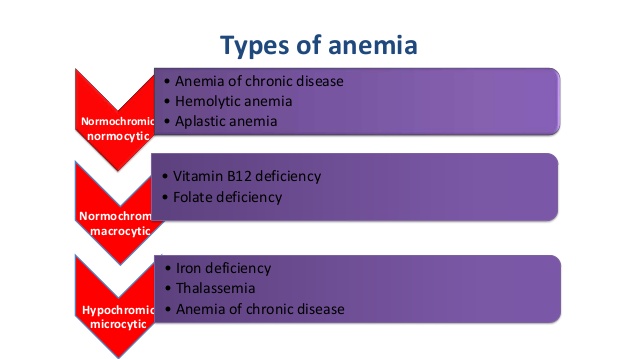
There are numerous various types of deficiency based anemias, and the most common forms are:
- Iron-deficiency;
- Methylcobalamin (Vitamin B12);
- Folic acid (Vitamin B9) deficiency.
- Ascorbic acid aka Vitamin C deficiency
- Vitamin E aka d-alpha-tocopherol and Pyridoxine (Vitamin B-6) deficiency
- Hypothyroidism
- Excessive Alcohol Consumption
- Lead Toxicity
- Chronic Infectious illnesses
Except for the above-listed deficiencies, a decrease of hemoglobin concentration in the bloodstream can be a result of some chronic medical conditions such as pregnancy, stomach ulcer, and drug addiction, some viral and bacterial infections, etc.
Each form of anemia has its symptoms and patients report dissimilar complaints depending on a type of hemoglobin deficiency.
Iron deficiency anemia
Iron is an essential nutrient that is required for the production of red blood cells in the body. When the iron content in the body reduces, the production of red blood cells is hampered which leads to iron deficiency anemia. Poor diet and chronic illness can also lead to iron-deficiency anemia.
Iron deficiency anemia symptoms include paleness of skin, frequent headaches, irritability, brittle hair and nails, and rapid heartbeat. This type of anemia can be treated by simple dietary modifications and taking oral iron supplements.
Vitamin deficiency
Vitamin deficiency is a type of anemia that occurs when there is a lack of vitamin B12 in our diet which can cause a reduced production of hemoglobin, vitamin B12 is usually found in animal products so vegans and vegetarians may lack this. Although it may not be down to just diet, some people cannot absorb vitamin B12 through the walls of the stomach. This type of anemia usually occurs in those over 40 with thyroid or diabetic problems. It is also more common in people of northern European descent with fair skin.
Hemolytic anemia
Hemolytic anemia is the condition in which the bone marrow in the body is not able to keep up with the production of red blood cells which are being prematurely destroyed by the body. Healthy red blood cells normally last between one hundred and one hundred and twenty days.
However, with hemolytic anemia, these cells are destroyed at a much faster rate and the bone marrow simply cannot produce these cells fast enough to replace them.
Symptoms of hemolytic anemia are dark-colored urine, fatigue, shortness of breath, pale skin, rapid heart rate, and an enlarged spleen.
Aplastic anemia
Aplastic anemia is characterized by an absence or reduction in the red blood cells. This can result from severe blood loss due to an injury, heavy menstruation, hepatitis, or exposure to certain toxins. A lack of red blood cells inhibits the disease-fighting ability of the body and the person becomes prone to various infections.
Lethargy, paleness of skin, heavy bleeding, rapid heartbeat, multiple infections, and heart failure are some of the common symptoms of Aplastic anemia.
People suffering from mild to moderate Aplastic anemia do not require treatment as long as the condition does not deteriorate further. For severe cases, treatment includes blood transfusions, blood, and marrow stem cell transplants, and medications.
Sickle cell anemia
Sickle cell anemia is an inherited life-long disease in which the body makes sickle-shaped (shaped like a ‘C’) red blood cells. Sickle cells contain abnormal hemoglobin and tend to form clumps. These clumps get stuck in the blood vessels causing pain, multiple infections, and serious organ damage.
Symptoms of sickle cell anemia include jaundice, high fever, rapid heartbeat, fatigue, paleness of skin, and severe pain in various body parts especially arms, legs, and stomach. A severe form of sickle cell anemia can lead to ulcers, cerebral hemorrhage, and orthopedic disorders.
What causes anemia
Some of the common causes of anemia are sudden blood loss due to an accident, surgery, or internal bleeding. Increased bleeding during menstruation period or absence of menstruation periods is one of the causes of low hemoglobin in women.
Anemia is a medical condition when the level of concentration of hemoglobin in the bloodstream falls below average. It can happen if the number of Red Blood Cells decreases or when the quantity of hemoglobin in each RBC falls below average. 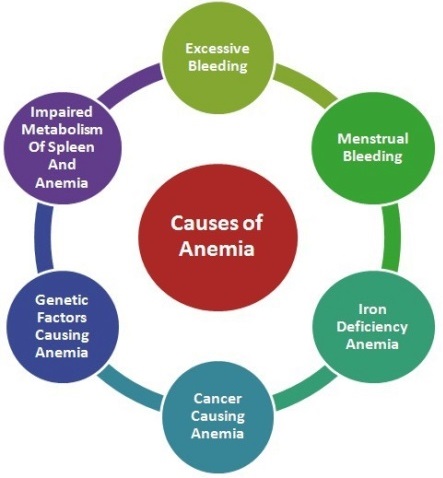 Both of these forms of anemia may develop as a result of different initiating factors. For example, a decrease in the number of RBC may follow severe bleeding (menstrual bleeding, trauma, labor, and delivery, etc.). In those cases, a body losing RBCs and it needs some substantial time to produce new. Also, this form of anemia may happen if the bone mare does not produce enough RBCs and this is usually a sign of some malignant blood disease. From another hand, a lower than normal concentration of hemoglobin in each RBC (erythrocytes) often happens in response to a deficit of some essential chemicals in the human body. Hemoglobin is the pigment that makes RBC red. It works as a vehicle for oxygen in our body.
Both of these forms of anemia may develop as a result of different initiating factors. For example, a decrease in the number of RBC may follow severe bleeding (menstrual bleeding, trauma, labor, and delivery, etc.). In those cases, a body losing RBCs and it needs some substantial time to produce new. Also, this form of anemia may happen if the bone mare does not produce enough RBCs and this is usually a sign of some malignant blood disease. From another hand, a lower than normal concentration of hemoglobin in each RBC (erythrocytes) often happens in response to a deficit of some essential chemicals in the human body. Hemoglobin is the pigment that makes RBC red. It works as a vehicle for oxygen in our body.
Poor nutrition is also a common cause of anemia. Nutrients like iron, folic acid, and vitamin B12 are essential for red blood cell and hemoglobin production. The other causes of low hemoglobin include kidney failure, cancer, or bone marrow failure in producing red blood cells.
Anemia is the deficiency of vigorous red blood cells. Without enough of these essential components, blood cannot carry enough oxygen to oxygenate every organ and tissue in the body. This leads to a variety of complications ranging from mild to severe. There are many types of anemia, but they can all be grouped by three causes: blood loss, destruction of red blood cells, and defective or diminished blood cells.
Below we’ll discuss 10 major and most common causes of anemia.
Internal bleeding
Internal bleeding, a possible result of traumatic injury or gastrointestinal illness, can cause anemia. Excessive bleeding can occur over a short period or the vessels can lose small amounts of blood over a long period. If not detected, conditions such as gastritis, ulcers, hemorrhoids, and cancer, as well as unidentified internal injuries, can also bleed and lead to anemia.
Pharmaceutical drugs
Most people use over-the-counter pain relievers to relieve headaches and muscle cramps and help prevent heart attacks and strokes. However, recent studies indicate that prolonged use of some medications without a prescription can damage gastric walls and increase the risk of major bleeding, which can lead to anemia.
Menstrual cycle and childbirth.
For many women, periods, pregnancy and childbirth are normal. However, under certain circumstances, any of these can lead to anemia. Excessive bleeding during menstruation results in significant blood loss in a relatively short time. If this occurs monthly, it can significantly lower iron levels, which in turn lowers the production of hemoglobin and red blood cells, causing anemia. During pregnancy, a growing baby can also deplete the mother’s iron stores. Excessive blood loss during childbirth can also negatively affect the level of red blood cells.
Iron deficiency
Anemia as a result of deficiency of Iron is one of the most common kinds of anemia. This type of anemia occurs when there is too little iron in the body. The most common cause of iron deficiency anemia is blood loss, although in some cases it is caused by poor iron absorption. Increasing your iron intake is pretty easy. Incorporating leafy greens and cooking with cast iron can increase the consumption of this essential mineral. However, animal sources (i.e. meat, fish) contain “heme iron”, which is better absorbed in the body than “non-heme iron” from vegetable sources. Iron supplements are also available.
Vitamin deficiency
Pernicious anemia develops when the body cannot absorb enough vitamin B12, and this is an autoimmune condition. In some cases, vitamin deficiencies are the result of a diet that does not contain enough folate and B vitamins. This condition can also develop secondary to a digestive condition, such as celiac disease or Crohn’s disease because the body cannot properly absorb B12 and others. nutrients from the foods you eat. In some cases, the body cannot process vitamin efficiently.
Bone marrow deficiency
The bone marrow contains stem cells, and the stem cells turn into red blood cells that carry oxygen throughout the body. A deficiency in bone marrow leads to anemia because it interferes with the body’s ability to adequately produce blood cells. In aplastic anemia, the bone marrow does not produce red blood cells; in lymphoma, the disease spreads in the bone marrow, affecting the production of blood cells.
Chronic kidney diseases.
Anemia often develops in people with advanced kidney disease; damaged kidneys do not produce enough of the hormone erythropoietin. Erythropoietin stimulates the bone marrow to produce red blood cells, so a deficiency in this hormone leads to anemia, which worsens with partial or permanent loss of kidney function. At this stage, the condition requires dialysis or transplantation. Anemia resulting from kidney disease often leads to heart and muscle complications. Increasing iron levels with red blood cell transfusions and dietary changes can help relieve symptoms of anemia, as can injections of synthetic erythropoietin.
Other diseases
The list of the most common illnesses that affect the creation of red blood cells includes diabetes, HIV/AIDS, cancer, and lupus. Inflammatory diseases such as rheumatoid arthritis and Crohn’s disease can also lead to anemia.
Destruction of erythrocytes aka red blood cells
The human body usually breaks down old or malfunctioning red blood cells in the spleen or other parts of the system during a process called hemolysis. Hemolytic anemia occurs when you have a low erythrocyte count due to excessive hemolysis in your body. Hemolytic anemia is an illness during which erythrocytes are destroyed quicker than the body can produce new cells. The damage to red blood cells is called hemolysis. Hemolytic anemia can be present at birth or develop later in life. Kidney and liver disease can cause this type of anemia. Exposure to certain chemicals or drugs, tumors, severe burns, various infections, autoimmune diseases, and some blood diseases all cause red blood cell destruction.
Old age
Anemia is a common problem in the elderly. A wide range of factors can contribute to anemia in this population. Insufficient diets in red meat and green leafy vegetables can cause anemia due to the reduction of iron and vitamin B12. Additionally, older people are more susceptible to chronic disease, which can lead to anemia. Stomach bleeding as a result of stomach ulcer, or intestine bleeding as a result of ulcerative colitis are other common causes of low hemoglobin in the elderly. Anemia must be treated promptly because it aggravates heart conditions and cognitive impairments, conditions common in the elderly.
What are the symptoms of anemia?
The symptoms of anemia are:
- Tiredness
- Easy fatigue
- Generalized muscular weakness
- Lethargy
- Headache
The symptoms of anemia in older patients are:
- Cardiac failure
- Angina pectoris
- Intermittent claudication
- Confusion
- Visual disturbances.
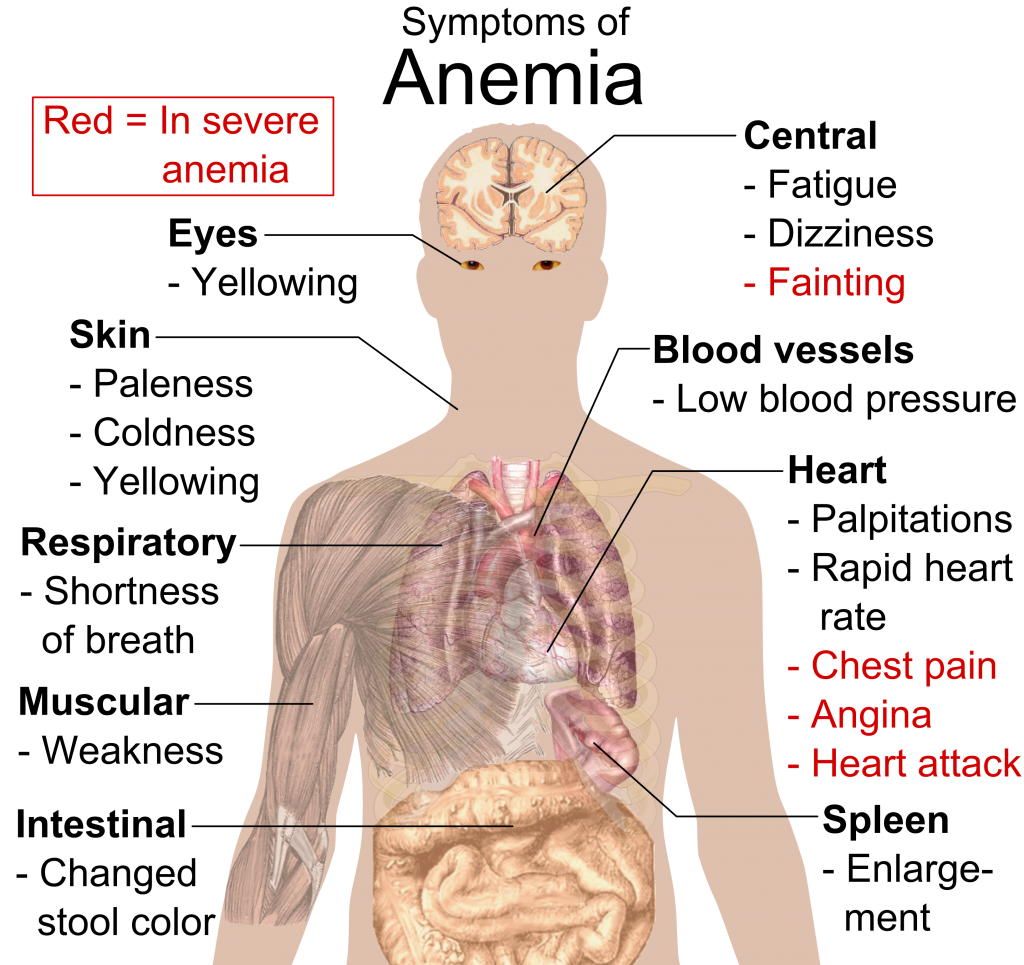 The signs of iron deficiency anemia are:
The signs of iron deficiency anemia are:
- Pale skin, especially on the face;
- Low energy;
- Fatigue;
- Exhaustion;
- Chest pains in most complicated cases;
- Dyspnea when the level of hemoglobin is very low;
- Rapid and irregular beating of the heart;
- Tachypnea;
- Blood Hypotension.
The symptoms of Methylcobalamin (vitamin B12) deficiency are different and include:
- Yellow staining of the skin and sclera (the whites of the eyes) by abnormally high blood levels of the bile pigment bilirubin. The yellowing extends to other tissues and body fluids
- Numbness and tingling in the hands and feet
- Equilibrium difficulties
- Confusion
- Personality changes and depression
Natural Treatment for anemia
There are several natural treatments for anemia that can help treat anemia by allowing the body to absorb iron easier and increase the absorption of oxygen. Vitamin B12 is commonly used to treat anemia. It is found mostly in dairy products such as milk and cheese and can also be found in significant amounts of animal protein, such as the kidney and liver.
Another commonly known natural remedy for anemia is Beetroot. The juice which is obtained from beetroot contains high levels of iron which strengthens the body and provides durability throughout the day. Furthermore, honey is an excellent producer of hemoglobin. With its high content of iron, copper, and manganese, honey should be regarded as a ‘must-have’ for anyone suffering from anemia. Vegetables such as lettuce and spinach should also be consumed to treat the disorder. This is because the iron in these foods is easily absorbed by the body which helps form hemoglobin and red blood cells.
Another product for the natural treatment for anemia that is overlooked is soy. Soy is rich in iron and also contains a high quantity of protein. People who suffer from anemia and digestive problems should drink soy milk due to it being easily digested. Almonds are also a useful remedy to combat anemia. This is because almonds are rich in copper which works together with vitamins to act as a catalyst in the synthesis of hemoglobin.
Eight do and don’t if you suffer from Anemia – follow this instruction during natural treatment for anemia
- Comprise the ingredients suggested for a particular type of your anemia.
- Take into consideration the ingredients in your foods and make sure that your meal is a good source of iron, Vitamin C, and B-vitamins. For more information use the On-Line Holistic Nutrition database.
- Avoid coffee, tea, beer, or soda during your meals because these drinks prevent iron digestion. As an alternative, drink orange, lemon, and lime juices. The high concentration of Ascorbic Acid supports iron absorption.
- Take multivitamins on a daily basis.
- Do not consume any additional iron dietary supplements unless prescribed by your attending physician.
- I usually recommend to my patients one glass of dry red wine every day during dinner.
- Vegetarians must watch their diet very thoroughly to make sure they are consuming enough proteins to build blood cells.
- Quit smoking.
- Reduce if possible your contact with toxic products such as cadmium, mercury, etc.
Diet for anemia – an essential part of any natural treatment for anemia
Diet for anemia is also one of the most important and essential additions used along with natural remedies for anemia and it has been proven to be effective. The best diet for anemia plan includes foods rich in iron and other vitamins essential to hemoglobin and red blood cell production. It should also include foods that help your body absorb iron better.

Add these foods to your diet to get more iron and help fight iron deficiency anemia:
- Leafy greens, especially dark ones, are among the best sources of iron.
- The liver is arguably the most popular organ meat. It’s rich in iron and folate. Some other iron-rich organ meats are heart, kidney, and beef tongue.
- Beans are good sources of iron for vegetarians and meat-eaters alike. They’re also inexpensive and versatile.
- All meat and poultry contain iron. Red meat, lamb, and venison are the best sources. Poultry and chicken have lower amounts. Eating meat or poultry with foods, such as leafy greens, along with a vitamin C-rich fruit can increase iron absorption.
- Some seafood provides iron. Shellfish such as oysters, clams, scallops, crabs, and shrimp are good sources. Most fish contain iron.
- Most root veggies are rich in minerals and can increase the blood count with regular inclusion in the diet. Carrots and sweet potatoes are also great to include in a daily diet due to their nutrient-rich content.
- Loaded with the goodness of nutrition, these seeds and nuts are rich in various minerals and vitamins. Moreover, regular intake of nuts not only provide ample nutrition but at the same time can be rich in fibers, which helps in increasing the blood count.
Herbs for anemia – popular natural treatment for anemia
Herbs for anemia is one of the natural remedies for anemia that can work great as a complementary choice. The following herbs for anemia can do wonders for anemia recovery:
- Also known as stinging nettle, this herb for anemia is very high in iron. However, what makes it even more valuable is the presence of vitamins A (retinol), B group, C (ascorbic acid), and K, all of which improve iron absorption in the body.
- Avocado is an herb for anemia that contains large amounts of iron, making them an ideal dietary add-on after major surgery. Although dietary folic acid (vitamin B9) deficiency is rare in Western countries thanks to the widespread fortification of flour, if perchance there is still a need for a little boost in folic acid levels, avocados are useful for that as well.
- Parsley, a popular green herb for anemia that is excellent for overcoming anemia. This is because it contains an impressive concentration of iron.
- There are two potential causes of iron-deficiency anemia: either you are not eating enough iron-rich foods or your body is not absorbing it properly. In any case, dandelion got you covered. Its leaves not only contain high levels of iron, but they also enhance the body’s ability to absorb this important mineral. This herb can be paired with others to boost its benefits, such as in this Anti-Anemia Dandelion and Nettle Tea.
Homeopathic treatment for anemia – #1 natural treatment for anemia
Homeopathic medicine has a dozen or more remedies, which may benefit in curing anemia.
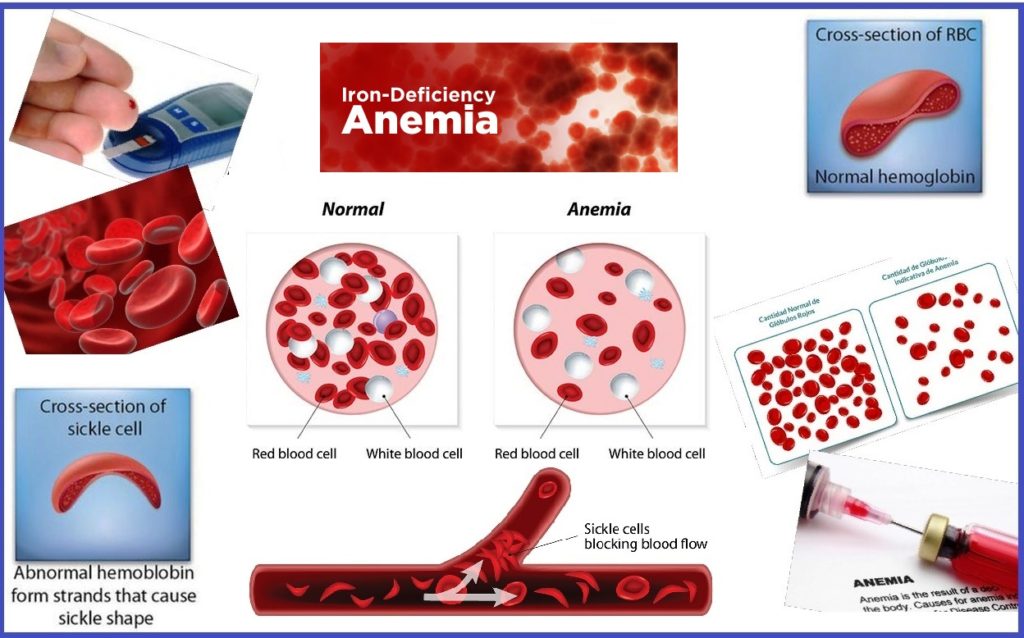
Ferrum metallicum [Ferr]
Iron is a recognized allopathic dietary supplement for anemia. At the same time, homeopathically prepared iron is beneficial for anemia related to iron deficiency. However, as always in homeopathy, this remedy is not universal for all forms of iron deficiency anemias and cautious personalization is essential.
If an individual has a look of full bloodedness or overabundance tailed by pallor or grayish of the skin of the face and swollenness of the limbs, then Ferrum is the remedy of choice. Ferrum metallicum is not the appropriate medicine for the anemia caused by loss of internal body juices (blood, lymph, etc.). For those forms of anemia, we prefer either Cinchona or maybe Natrum Muriaticum. In cases of Ferrum, the mucous tissues are pale.
Pulsatilla
Pulsatilla is the perfect antidote for “Iron overdose”, and therefore point to the conditions caused by excessive and persistent consumption of this ingredient. The Pulsatilla patient always feels chilly and suffers from the stomach and menstrual disorders. Therefore, Pulsatilla should be prescribed either to women with very light and missing periods or to men that look and behaves like a woman and has anemia.
Calcarea carbonica [Calc]
Calcarea is a constitutional remedy and may be beneficial for any anemia if constitution wise it is similar to the particular patient. In the case of constitutional treatment, we don’t pay too much attention to the symptoms of anemia, but more to the appearance and behavior of the individual. Calcarea carbonica patients are usually puffy and overweight because they suffer from hypothyroidism. Their head is usually large. These people have a craving for eggs and don’t like and don’t drink milk. They are sweating during the night.
Arsenicum Album [Ars]
In a therapeutic dose, Arsenicum Album is a toxin that destroys the red blood cells. That’s why this famous homeopathic remedy is #1 for toxic forms of anemia or pernicious anemia. Or in anemias due to a malarial or toxic influence. Dr. Blackly testified about six patients with pernicious anemia successfully cured with the homeopathic dilution of this remedy. Arsenicum Album is not useful for the treatment of the simple forms of anemia. The constitutional signs for this remedy are:
- Unnecessary prostration;
- Significant swollenness;
- Forceful and unbalanced heart rhythm;
- Craving for acids and alcohol;
- Thrilling anxiety and skinniness;
- Irritable stomach;
- Intense thirst.
Helonias is an exceptional homeopathic medication for anemia and chlorosis. Helonias is most appropriate in cases of anemia from lengthy hemorrhages, especially in females. These women are “too exhausted to fall asleep” and they experience burning aches in muscles all over the body. The primary characteristic modality for Helonias is that these patients feel better when they can engage attention to their condition. Of course, these patients (usually women) feel better when examined by a physician in the office. The typical anemia related to this homeopathic remedy has anamnesis of instabilities in the urinary and reproductive systems. “Exhausted, fatigued and anemic women need Helonias for the perfect, safe and efficient cure”, professor E. G. Jones said.
Natrum Muriaticum is one of the best homeopathic medicines in the anemia clinic. Natrum Muriaticum patients are pale, and, regardless of the normal appetite, they are pathologically skinny. These patients (mostly women) experience episodes of throbbing headache and associated with dyspnea. The general characteristic modality for Natrum Muriaticum is that these patients feel worse when they are going upstairs.
The homeopathic formula for anemia treatment.
Fe-min tablets represent a homeopathic formula – a combination of a few different homeopathic remedies for anemia. This formula is an excellent homeopathic remedy for the lack of hemoglobin in the bloodstream – harmless and efficient. Fe-min combination delivers a cure for iron deficiency anemia. It rapidly increases the level of iron in the bloodstream.
The main ingredients of Fe-min tablets are:
- Ferrum phosphoricum delivers natural iron to the system and aids in the manufacturing of RBC and hemoglobin. Ferrum phosphoricum is a perfect homeopathic medicine for individuals who feel fragile and drained due to losing iron from the organism as a result of chronic diseases, hemorrhages, or as a result of insufficient iron absorption from food.
- Kali Phosphoricum is a different beneficial homeopathic drug for the iron deficiency forms of anemia. Kali Phosphoricum supports nerves’ reinforcing, heals migraines, and dizziness.
- Calcarea phosphoricum improves the functionality of the bone mares fights faintness, paleness, and enervation that resulted from iron deficiency.
- Calcarea fluorica enhances the internal energy and assists to upsurge the iron absorption of into the bloodstream. Calcarea fluorica declines the signs of anemia by improving the fabrication of hemoglobin.
It is essential to discover the particular grounds of anemia and eliminate any dietary shortages. In a majority of clinical cases, it is the gastrointestinal and assimilative ability of the individual that results in anemia. Nutritional deficit happens rarely nowadays. Homeopathic remedies efficiently fix such disorders in the organism, and the system begins adapting the food. Thus, essential ingredients become appropriately consumed respectively improving body functions that require these nutrients. Therefore, the body heals itself and cures the anemia naturally.
Anemia treatment by Doctor Tsan
At the Philadelphia Homeopathic Clinic Victor Tsan, MD and his associates cure different forms of anemia using a combination of various holistic techniques including homeopathy, acupuncture, and medicinal herbs.
To make an appointment for the holistic evaluation and discuss with Dr. Tsan if alternative medicine is a good treatment option for you contact our office or use our online scheduling system
Comments
Post a Comment